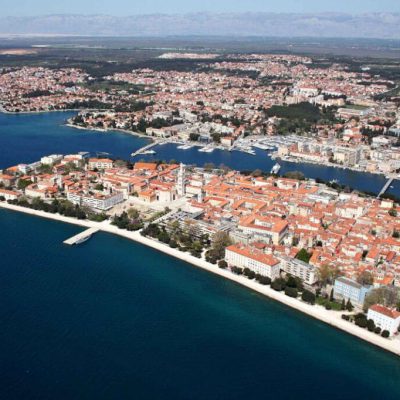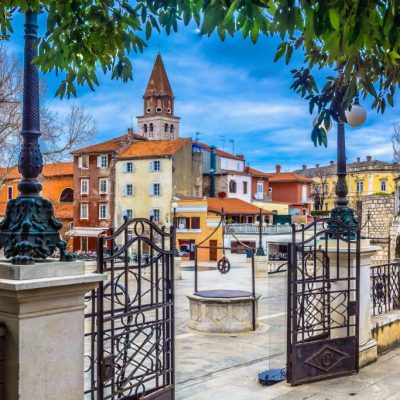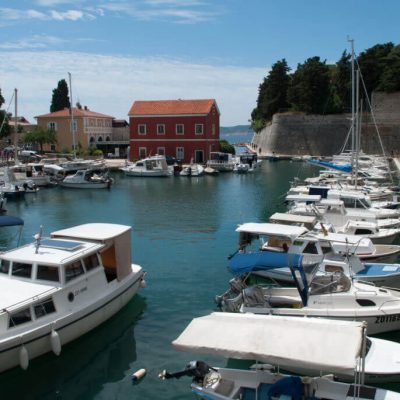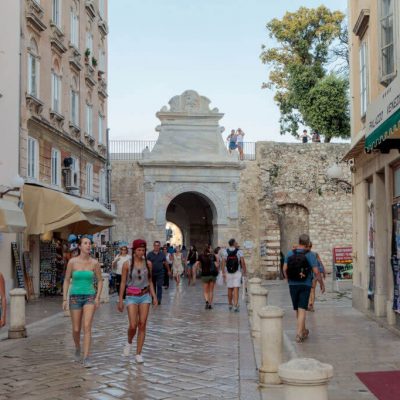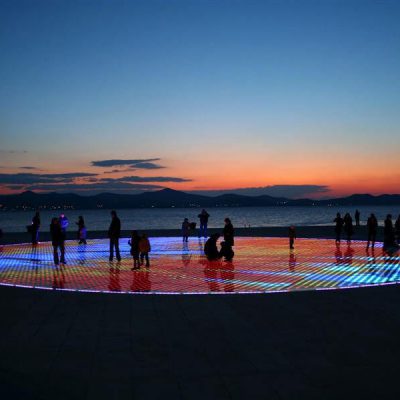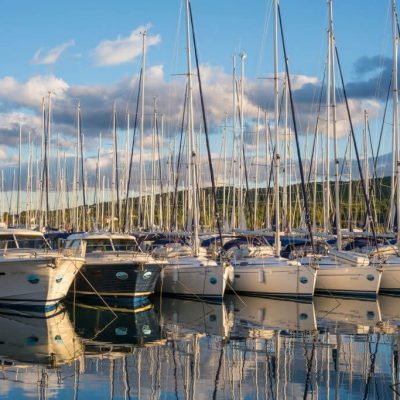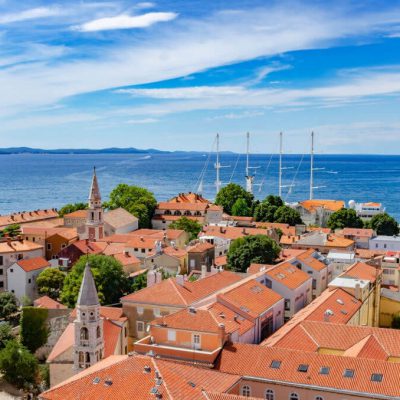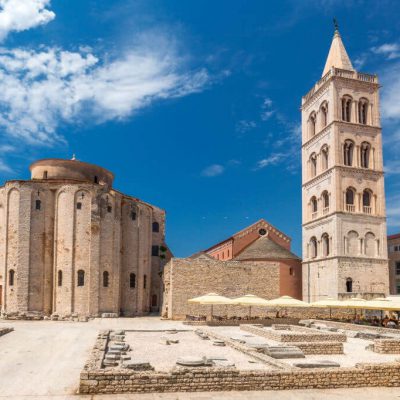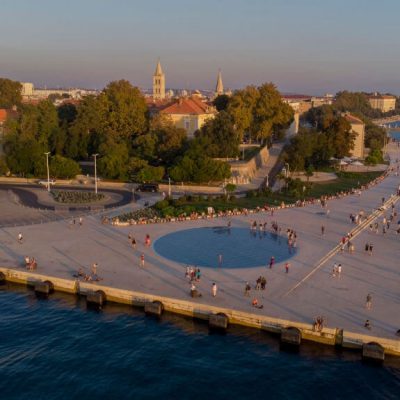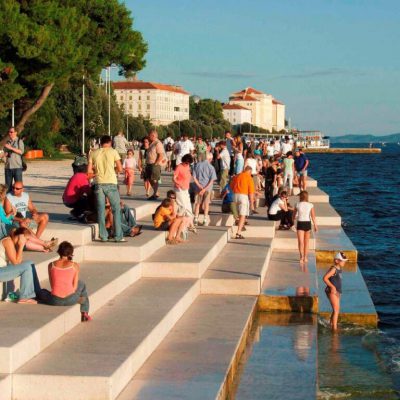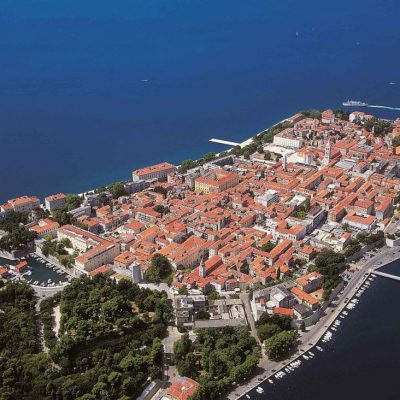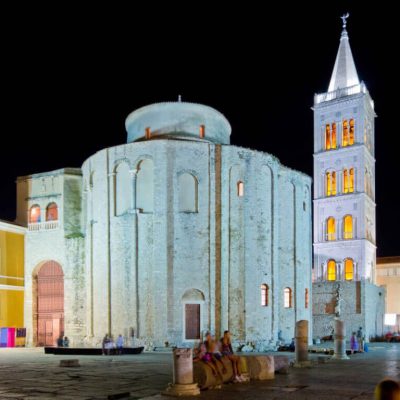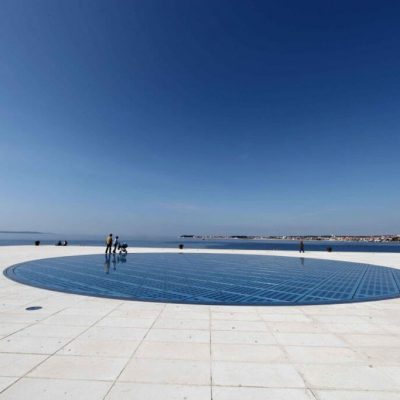Zadar is a port city in northern Dalmatia on the Croatian Adriatic. It´s a historical center of Dalmatia, more than 2000 years old. Zadar´s Old Town is located on a peninsula sheltered by walls built by Romans. Quiet marble streets will take you to Romanesque churches, beautiful beaches, theatres, museums, fish restaurants and a rising bar scene. Dozens of islands and five national parks rich in natural beauty lie only an hour’s drive from Zadar.
About
Zadar is a port city in northern Dalmatia on the Croatian Adriatic. It’s a historical center of Dalmatia, more than 2000 years old. Zadar’s Old Town is located on a peninsula sheltered by walls built by Romans. Quiet marble streets will take you to Romanesque churches, beautiful beaches, theatres, museums, fish restaurants and a rising bar scene. Dozens of islands and five national parks – Paklenica, Kornati, Plitvice lakes, Krka waterfalls and Northern Velebit – rich in natural beauty, lie only an hour’s drive from Zadar.
The Zadar Archipelago consists of some 300 islands with beaches that run into crystal clear water. The region is very Mediterranean in nature with olive trees growing on the islands, and farming and fishing being the main means of livelihood. Most of them are serviced by ferries and have hotel accommodations. Some of the more popular islands include Dugi Otok, Ugljan, Pasman, Pag, Premuda, Molat, Silba, Olib, and Kornati National Park.
Useful info
Tourist Information Centre
Tourist Information Centre is at Mihe Klaića 2, info@tzzadar.hr
Zadar has a Mediterranean climate, with dry, hot summers and wet, cool winters.
All major items brought into the country (laptops, boats, sauna equipment) must be declared; to do so ensures you will be
allowed to take them back when you leave. Keep receipts in order to qualify for a VAT refund at all border customs offices. Any Croatian art or cultural works must receive export approval before purchase.
Every year on the night of July’s full moon, Zadar’s electric lights are turned off for the Night of the Fool Moon Festival, when the Riva glows under the lights of the moon, torches, and candles. It is on this night that Zadar celebrates regional Croatian culture and customs with floating markets, impromptu restaurants, singing, dancing, and plenty of food.
The director Alfred Hitchcock famously said that “the sunset in Zadar is the world’s most beautiful and incomparably better than that of Key West, Florida”.
Postal service
Zadar has a post office on Kralja S. Držislava 1 Street which works from Monday to Friday 7 a.m. to 8 p.m., and 7 a.m. to 7 p.m. on Saturdays.
If all you need to do is send a postcard or a letter, you can buy stamps on pretty much any kiosk, just make sure they’re the right value for what you are sending and where. Once you put it on, drop your mail in any post box. These are the small yellow boxes attached to buildings around the town.
Banks
Several banks have their offices in Zadar: Zagrebačka banka, Erste bank, Croatia banka, OTP banka, Hypo-Alpe-Adria bank, Raiffeisen bank, Splitska banka etc.
You can change money in travel agencies, and there’s an ATM and an exchange office at the bus terminal.
Traffic
Zadar is easily accessible via major Croatian motorways. Journey time between Zagreb and Zadar is about 2.5 hours depending on when you travel.
The Zadar Airport is 10 km to the east from the town centre. There are daily flights to Zagreb and direct international flights in the summer. Buses connect the terminal, the city bus station and the quayside near the ferryport on the Old Town peninsula. Bus lines are organised to connect with the flight timetable, and one-way tickets cost 25 KN.
Buses and trains are frequent, convenient and affordable. A single ticket to Zagreb costs around 125 KN. The bus station is on the crossroads northeast of the Old Town heading towards Split, Rijeka and Zagreb. Luggage storage is in the ticket hall and works from 06:00 to 22:00 and costs 2.20kn per hour. Toilets are on the right as you face the building from the platforms. At least one snack bar works all night, and news kiosks, bakeries and a mini-market are all open from about 06:00 to 22:00, except weekends, when they may close earlier.
The train station is right next to the bus station. Journeys between Zadar and Zagreb or Split are possible, but involve changing trains and take considerably longer than travel by bus. The fastest connections leave Zagreb for Zadar at 10:55 throughout the tourist season. Journey time is about 71⁄2 hours, involving a change at Knin.
Zadar is a centre of nautic tourism with numerous marinas in the city and its surroundings. You can also get to Zadar from Italy by Ancona-Zadar ferry.
Visit
St Donatus’ Church was built in the early 9th century and is one of the finest examples of Byzantine architecture in Croatia. It often hosts a variety of musical and cultural events.
The enchanting Cathedral of St Anastasia was built in the 9th century and rebuilt in a Romanesque style several years later. It is the largest cathedral in Dalmatia and home to various paintings and Baroque artifacts.
The Forum is one of Zadar’s main squares, also known as Zeleni trg (Green Square). Remains of ancient architecture trace its history back to the 1st century.
The Archaeological Museum is one of the most important museums in the region with its collection of local artifacts dating from prehistoric times.
The Sea Organ on Zadar’s Riva is a system of pipes which creates sounds based on the movement of the sea. The sounds are accompanied by vizualizations on a light display.
The Church of St. Mary, founded in 1066, houses one of Zadar’s most valuable collections of antique religious paintings, reliquaries, crosses, gold and silver embroidery in Byzantine style.
Five Wells Square is built around ornate wells under which a huge water tank was built in the 16th century during the Turkish attacks. After the Turks retreated, the city built a park over the fortifications and it includes a concrete square built around the wells. The wells no longer provide drinking water, but they do serve as “gates” for skateboarders, who like to practice their techniques on the span.
The Museum of Ancient Glass contains one of the finest collections of Roman glassware outside Italy, with a profusion of goblets, jars and vials retrieved from archeological sites across Dalmatia. As part of the museum there is a souvenir workshop where you can learn more about the almost forgotten craft of blowing glass.
Recreation
You can swim at the most popular beaches: Kolovare (close to the city center), Borik (in a massive hotel complex with activities such as parasailing and water slides) and Vitrenjak, which is close to Zadar’s sailing club Uskok.
The Kolovare recreation center offers basketball courts, football fields and tennis courts.
There are a lot of opportunities for rafting on the Zrmanja River, trekking around the islands, hiking, free rock climbing in Paklenica National Park, cave exploration, or simply walking around.
Zadar’s surroundings are ideal for a spot of hiking and biking even in high summer. The Ravni Kotari plains in the hinterland offer gentle terrain for a spot of touring. One of the oldest cycling routes is between Zadar and Benkovac, where you can experience local hospitality in the surrounding villages and visit the ancient ruins of Asseria.
Thanks to an extremely indented shoreline, over 200 islands and islets, many straits, channels and coves and a suitable climate, the waters of Zadar are a paradise for all sorts of waters activities.
Gastro
Try a fish stew called “brodet”, which is cooked in numerous different ways and can be made from different types of fish mixed with crabs, sometimes shellfish or even fish on the grill, salted with salt from the island of Pag.
Don’t miss your chance to taste Paški sir (cheese from Pag), Dalmatian prosciutto, lamb on the spit and homemade olive oil.
Wines
As an aperitif, try a glass of Maraschino, an original dessert liqueur made from Maraska cherries grown in the region which can be had in alcoholic or nonalcoholic forms. According to legend, alcoholic Maraschino, usually a treacly sweet cherry liqueur, was first made by monks in the 16th century and was thought to improve the disposition. Today the liqueur is made in Zadar in a factory near the footbridge.
Local wines include Pošip bijeli, Cabernet sauvignon, Vranac, Dingać, Babić, Merlot, Chardonnay, Maraština, Debit etc.



